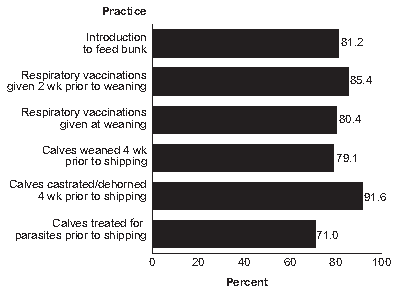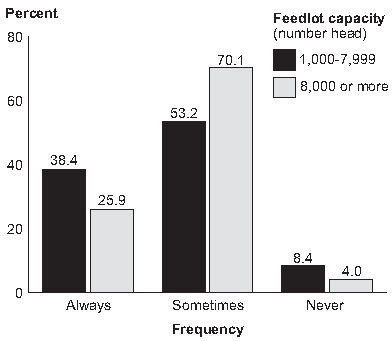



Importance of Pre-arrival Management Practices to Operators of US Feedlot
Pre-arrival management practices can help reduce death loss and cattle sickness in feedlots. Implementing these practices in the early stages of the production process can help improve the resistance of cattle to infectious disease before they arrive in feedlots, according to the US Animal and Plant Health Inspection Service.By identifying
which pre-arrival practices are most important to feedlot
operators, suppliers and other industry stakeholders can
focus on the practices that are most beneficial and that
might be financially rewarding. In addition, when feedlot
cattle suppliers are aware of feedlot operators’ priorities,
the health of the animals during the feeding phase and
their subsequent growth can be optimized.
The US Department of Agriculture’s National
Animal Health Monitoring System (NAHMS) conducted
the Feedlot 2011 study, an in-depth look at large
feedlots (1,000 head or more capacity) in 12 States2
and small feedlots (fewer than 1,000 head capacity) in
13 States.3
Large feedlots accounted for 82.1 per cent of the
January 1, 2011, inventory of feedlot cattle in all US
feedlots but only 2.8 per cent of all feedlots. The 12
participating States accounted for over 95 per cent of the
inventory of cattle in large feedlots (NASS, Cattle on
Feed, 18 February 2011). Small feedlots accounted for
16.0 per cent of the inventory on all US feedlots and
92.9 per cent of all US farms with cattle on feed. The 13
participating States accounted for 85.4 per cent of US
farms with fewer than 500 cattle on feed and 90.5
per cent of the inventory on farms with fewer than 500
cattle on feed (NASS, 2007 Census of Agriculture).
Study results presented in this information sheet reflect
only large feedlots,4 which were divided into two groups:
those with a capacity of 1,000 to 7,999 head and those
with a capacity of 8,000 or more head.
As part of the NAHMS Feedlot 2011 study,
operators were asked to assess a list of six pre-arrival
management practices as extremely effective, very
effective, somewhat effective, or not effective for
reducing sickness or death loss. All six listed pre-arrival
management practices were deemed to be extremely or very effective by at least 71.0 per cent of feedlots
(figure 1).

The practice perceived by feedlot operators to be
the most effective was castrating and dehorning calves
at least 4 weeks prior to shipping (91.6 per cent of
feedlots). Treating calves for external or internal
parasites prior to shipping was believed to be extremely
or very effective by the lowest per centage of feedlots
(71.0 per cent). These results show that all listed prearrival
practices have perceived importance, but some
are thought to be more important than others.
The majority of feedlot operators sometimes
received pre-arrival information on incoming cattle;
however, a substantial per centage still lacked access to
such information (figure 2). Operators on a higher
per centage of feedlots with a capacity of 1,000 to 7,999
head (38.4 per cent) reported always having access to
pre-arrival information compared with 25.9 per cent of
operators on feedlots with a capacity of 8,000 or more
head. Overall, operators on 53.2 per cent of feedlots with
a capacity of 1,000 to 7,999 head and 70.1 per cent of
feedlots with a capacity of 8,000 or more head were
sometimes given information on pre-arrival practices.
From these data, it is apparent that limitations still exist
when attempting to pass information on pre-arrival
practices to feedlots, especially for feedlots with a
capacity of 1,000 to 7,999 head.

Operators on 69.3 per cent of all feedlots believed that pre-arrival processing information was very important (figure 3). These findings are consistent with the belief that these pre-arrival practices help to support the health and well-being of feedlot cattle through decreased sickness and death loss at the feedlot. Operators on an additional 23.8 per cent of all feedlots believed that information on pre-arrival processing was somewhat important. From these data, it is apparent that feedlot operators find great value in pre-arrival information.

Summary
Operators on feedlots with a capacity of 1,000 or
more head believed that pre-arrival processing was
extremely or very effective in reducing sickness and
death loss of cattle in feedlots. Castrating and dehorning
calves at least 4 weeks prior to shipping was deemed by
91.6 per cent of feedlot operators as a very or extremely
effective pre-arrival practice.
Although feedlot operators believed that pre-arrival
management practices were crucial to the health of
animals, information on pre-arrival processing was not
always available to operators. Operators on only 34.7
per cent of all feedlots always had pre-arrival information
available. This finding might reflect the challenge of
moving data/information with shipped cattle, especially
when many smaller groups of cattle are involved.
Furthermore, the cost of transmitting data with the
animals may be higher than the cost differential between
those with and without data on pre-arrival management.
Improving the per centage of feedlots that always
have pre-arrival information available should be an area
of focus. Working with the different groups involved in
the marketing channels to improve communication and
consistency is one way that improvements can be made.
In addition, developing a more systematic method of
transferring data when the ownership of cattle is
transferred from the supplier to the feedlot might help to
increase the availability of pre-arrival processing
information, which could improve the health of feedlot
cattle in feedlots, a major concern for owners and
consumers.
2 Arizona, California, Colorado, Idaho, Iowa, Kansas, Nebraska, New
Mexico, Oklahoma, South Dakota, Texas, Washington.
3 Illinois, Indiana, Iowa, Kansas, Michigan, Minnesota, Missouri,
Nebraska, Ohio, Pennsylvania, South Dakota, Texas, Wisconsin.
4 Information on small feedlots is available at:
http://www.aphis.usda.gov/animal_health/nahms/feedlot/index.shtml


